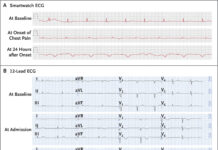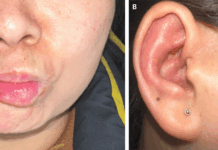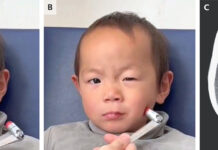Periorbital Edema in Dermatomyositis
A 61-year-old woman presented to the rheumatology clinic after experiencing periorbital edema and shoulder weakness for 6 months. She stated that she had no dyspnea, cough, or joint pain. The physical examination revealed erythema of the upper and lower eyelids as well as significant periorbital edema (Panel A). There was also midfacial erythema including the nasolabial folds, upper back poikiloderma, and 4/5 strength in both shoulder abductors. The creatine kinase level was 6300 U per litre (reference range, 24 to 170), the antinuclear antibody titer was 1:320, and the anti-p155/140 myositis autoantibody was positive. Based on these findings, the patient was diagnosed with periorbital edema in dermatomyositis.
The right deltoid muscle displayed edema on magnetic resonance imaging. A skin biopsy revealed that the patient had interface dermatitis. A dermatomyositis diagnosis was made. Dermatomyositis is a type of idiopathic inflammatory myopathy that causes immune-mediated muscle and skin damage. In dermatomyositis, the pathognomic skin finding of a periorbital heliotrope rash may be followed by eyelid edema, as in this case. The shawl sign and a malar rash that did not spare the nasolabial folds were also typical skin findings in this patient. Treatment began with oral glucocorticoids, methotrexate, and intravenous immune globulin. Cancer screening came out negative. The patient’s weakness, rashes, and periorbital edema had resolved at the 2-month follow-up (Panel B).
Dermatomyositis – an autoimmune condition
Dermatomyositis is an autoimmune condition in which lymphocytes infiltrate the skin and skeletal muscles. Although idiopathic, the disease could be the result of a genetic interplay (determining the immune system response) and a viral infection. This contact may activate the complement cascade and increase the expression of cytokines and chemokines, resulting in microangiopathy.1 Polymyositis is characterised by muscle involvement, which can be diffuse or localised (the skin is not affected). Dermatomyositis has a variety of cutaneous symptoms, the most frequent of which is a lilac-colored (heliotrope) rash around the eyes, nose, and cheeks. Lesions on the forehead, chest, elbows, knees, and knuckles are also prevalent. The exanthem may be itchy.
Bilateral periorbital edoema, as seen in our patient, can occur in severe cases. The periorbital area may be the only area affected, especially in the early stages of the disease. Gottron’s papules, cuticular erythema, telangiectasia, and papulosquamous eruptions on the hairline, face, and trunk are further skin symptoms. It is uncommon to have vesico-bullous dermatomyositis. Fever can potentially be a sign of dermatomyositis. Women are twice as likely as men to be affected by the condition. Elevated serum levels of skeletal muscle enzymes (e.g., creatine kinase, lactic dehydrogenase, and aldehyde-lyase) are related with dermatomyositis. Myopathic findings are revealed by electromyography, and skin and muscle biopsies confirm the diagnosis.
Differential diagnosis
Trichinosis, systemic lupus erythematosus, periodic syndrome associated with tumour necrosis factor (TNF) receptor, and bilateral internal jugular thrombosis are all possible diagnoses for bilateral periorbital edoema. Diseases that cause a drop in blood albumin levels (e.g., cirrhosis, nephrotic syndrome, protein-losing enteropathy) frequently cause generalised edoema but not fever. Allergic reactions can produce periorbital edoema as well, but they are rarely accompanied by fever.
Dermatomyositis might be difficult to detect if the condition is limited. The majority of treatment is corticosteroids, however intravenous immune globulin therapy may sometimes be required.6 Dermatomyositis is linked to infection (e.g., Lyme disease or enterovirus infection), autoimmune illnesses (e.g., rheumatoid arthritis, systemic lupus erythematosus, or systemic sclerosis), sarcoidosis, and malignancy. The link between dermatomyositis and neoplasia is widely established, particularly in people over the age of 40. The most prevalent malignant neoplasms linked with dermatomyositis are ovarian, lung, gastrointestinal system (pancreatic, colorectal, gastric), and non-Hodgkin’s lymphoma. It is critical to rule out an underlying neoplasm, especially if the patient has a history of malignancy.
Source: NEJM




